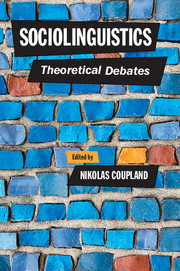Book contents
- Frontmatter
- Contents
- List of contributors
- Preface and acknowledgements
- 1 Introduction: Sociolinguistic theory and the practice of sociolinguistics
- Part I Theorising social meaning
- 2 The “push” of Lautgesetze, the “pull” of enregisterment
- 3 Variation, meaning and social change
- 4 Indexicality, stance and fields in sociolinguistics
- 5 Sociolinguistic differentiation
- Part II Language, markets and materiality
- Part III Sociolinguistics, place and mobility
- Part IV Power, mediation and critical sociolinguistics
- Part V Sociolinguistics, contexts and impact
- Part VI The evolution of sociolinguistic theory
- Index
- References
3 - Variation, meaning and social change
from Part I - Theorising social meaning
Published online by Cambridge University Press: 05 June 2016
- Frontmatter
- Contents
- List of contributors
- Preface and acknowledgements
- 1 Introduction: Sociolinguistic theory and the practice of sociolinguistics
- Part I Theorising social meaning
- 2 The “push” of Lautgesetze, the “pull” of enregisterment
- 3 Variation, meaning and social change
- 4 Indexicality, stance and fields in sociolinguistics
- 5 Sociolinguistic differentiation
- Part II Language, markets and materiality
- Part III Sociolinguistics, place and mobility
- Part IV Power, mediation and critical sociolinguistics
- Part V Sociolinguistics, contexts and impact
- Part VI The evolution of sociolinguistic theory
- Index
- References
Summary
Introduction
The perspective that I will develop in these pages, what has come to be referred to as the “Third Wave” approach to variation, takes as basic that the meaningfulness of sociolinguistic variation is not incidental, not a by-product of social stratification, but a design feature of language. Sociolinguistic variation constitutes a system of signs that enables the nonpropositional expression of social concerns as they unfold in interaction. It allows people to say things without putting them into words, making it essential to social life and part of the pragmatics that link speech to the wider social system. I will argue further that language is not just a system that happens to change, but a system whose change is central to its semiotic function. Variation is a system of signs that enact a continually changing social world, and it is the potential for change in the meanings of these signs that makes language viable for human life.
This perspective appears to conflict with some of the basic tenets of the view of variation that emerged from work in the First Wave and that endure in much current work in variation. To some extent, this is because the First Wave grew out of the structuralist study of sound change and is primarily concerned with presocial cognitive forces giving rise to change and with macrosocial patterns of variation as structuring the regular social contact that accounts for the spread of change. This limits the view of social meaning to forces deriving from the macrostructure of society, hence external to language. My argument will be that social meaning in variation is an integral part of language and that macrosocial patterns of variation are at once the product of, and a constraint on, a complex system of meaning.
Three waves real quick
The First Wave of survey studies found a robust and repeated pattern of variation correlating with macrosociological categories, showing that change enters communities at the lower end of the socioeconomic hierarchy, and spreads upward. According to the model that emerged in the First Wave, sound change is presocial, originating in the most unconscious and systematic reaches of the speaker's linguistic system and emerging in the speaker's most unmonitored speech, the vernacular.
- Type
- Chapter
- Information
- SociolinguisticsTheoretical Debates, pp. 68 - 85Publisher: Cambridge University PressPrint publication year: 2016
References
- 39
- Cited by

